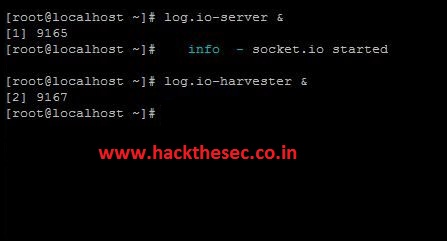Monitor Server Logs in Real-Time with "Log.io"
Log.io is a small application build on Node.js and Socket.io for monitoring real time Linux server logs through web interface.
On RHEL/CentOS 7
Install Epel repositories using the following command.
yum install http://fedora.mirrors.telekom.ro/pub/epel/7/x86_64/e/epel-release-7-2.noarch.rpm
On RHEL/CentOS 6
--------------------- On RHEL/CentOS 6.x - 32 Bit ---------------------
yum install http://fedora.mirrors.telekom.ro/pub/epel/6/i386/epel-release-6-8.noarch.rpm
--------------------- On RHEL/CentOS 6.x - 64 Bit ---------------------
yum install http://fedora.mirrors.telekom.ro/pub/epel/6/x86_64/epel-release-6-8.noarch.rpm
After added the Epel repositories you can do a system upgrade by using following command line.
yum update
Now Install Node.js and NPM
Node.js is an open-source, cross-platform JavaScript run-time environment that executes JavaScript code server-side. Historically, JavaScript was used primarily for client-side scripting, in which scripts written in JavaScript are embedded in a webpage's HTML and run client-side by a JavaScript engine in the user's web browser. Node.js lets developers use JavaScript for server-side scripting—running scripts server-side to produce dynamic web page content before the page is sent to the user's web browser. Consequently, Node.js represents a "JavaScript everywhere" paradigm, unifying web application development around a single programming language, rather than different languages for server side and client side scripts.now install the nodejs using following command line.
curl --silent --location https://rpm.nodesource.com/setup_5.x | bash -
yum install -y nodejs
Install and Configure Log.io Application
Log.io application must be installed through NPM by specifying a valid local system user ( example - root) i recommend install this application through root user. now install the application using following command.
npm install -g log.io --user "root"
after the completed installation the application will create a folder which is hidden the folder name is "Log.io" in centos 7 the folder path is below
cd /root/.log.io
ls
after that you will see three file
harvester.conf, log_server.conf, web_server.conf
Now it's time to configure Log.io to monitor local log files in real time.
- The harvester file is for watches the changes in specified local log files declared in its configuration and send new log to the server. - harvester.conf
First open the harvester.conf file, by default you will see have some setting the monitor Apache log
nano harvester.conf
my harvester.conf file below
exports.config = {
nodeName: "application_server",
logStreams: {
apache: [
"/var/log/httpd/access_log",
"/var/log/httpd/error_log"
],
SecureLog: [
"/var/log/secure"
],
MySqlLog: [
"/var/log/mysqld.log"
]
},
server: {
host: '0.0.0.0',
port: 28777
}
}
nano log_server.conf
exports.config = {
host: '0.0.0.0',
port: 28777
}
web_server.conf - This configuration file is for web interface. by default the web portal is accessible on port 28778(all interface). Also using this file you can increase the security by using HTTP authentication,securing the web interface with SSL, disallow logs from specific ip address and restricting the web interface access to the specific ip.
my web_server.conf file below
nano web_server.conf
exports.config = {
host: '0.0.0.0',
port: 28778,
/*
// Enable HTTP Basic Authentication
auth: {
user: "hackthesec",
pass: "1234346"
},
*/
/*
// Enable HTTPS/SSL
ssl: {
key: '/path/to/privatekey.pem',
cert: '/path/to/certificate.pem'
},
*/
/*
// Restrict access to websocket (socket.io)
// Uses socket.io 'origins' syntax
restrictSocket: '*:*',
*/
/*
// Restrict access to http server (express)
restrictHTTP: [
"192.168.29.39",
"10.0.*"
]
*/
}
firewall-cmd --add-port=28778/tcp --permanent
firewall-cmd --add-port=28777/tcp --permanent
firewall-cmd --reload
Start Log.io Application using following command line
------ First start server in background ----
log.io-server &
--- Start log harvester in background -----
log.io-harvester &
After the server has been started open your browser and hit enter with your ip and the declared port
example - http://192.168.2.253:28778
To stop Log.io application run the following command.
pkill node
Log.io = https://github.com/NarrativeScience/Log.io
http://logio.org/






